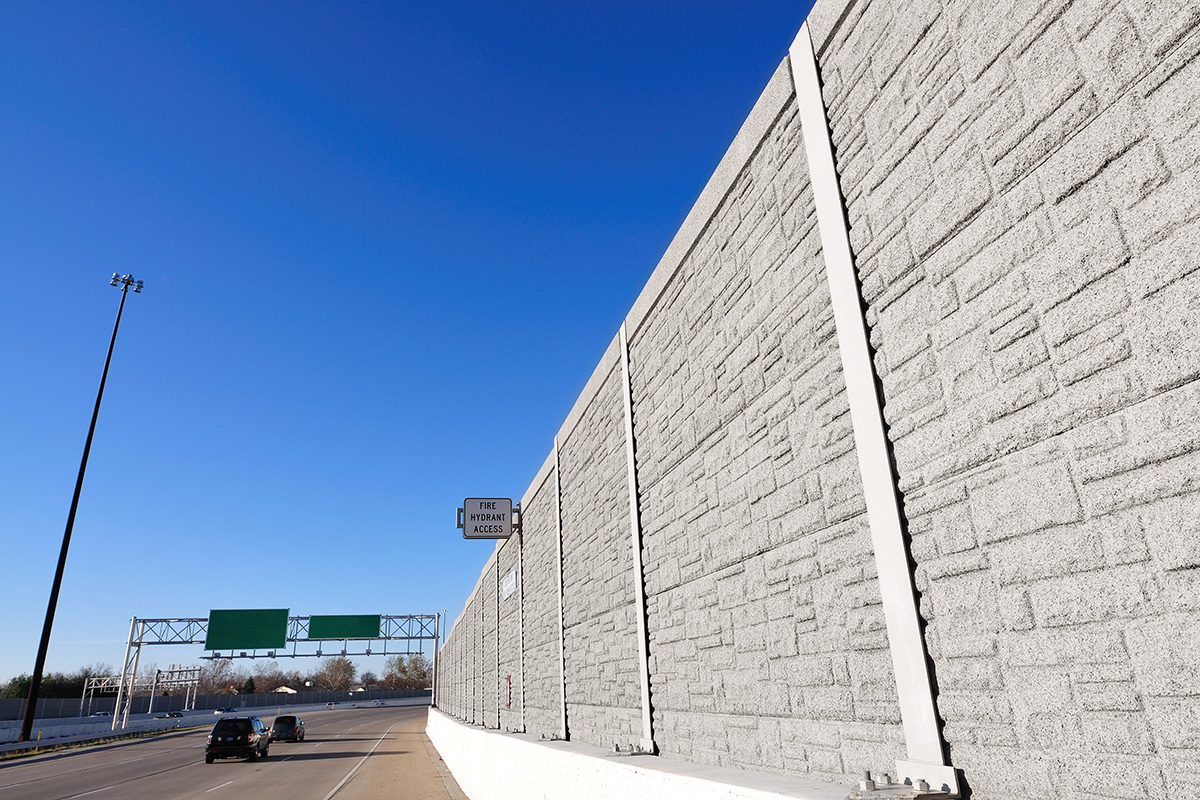They're massive, they're everywhere and they're surprisingly misunderstood—here's what a highway wall is really for

Here’s Why Highways Have Those Concrete Walls Alongside Them (It’s Not What You Think!)

They’re long, gray and about as scenic as a DMV line—those concrete highway walls that you notice only when you’re stuck in traffic, wondering what life choices led you to a standstill behind a truck hauling live chickens in 90-degree weather. The walls are usually not much to look at, but it’s better than chicken butts. And perhaps you’ve thought, Well, at least that highway wall will keep that semi from crashing and spilling chickens into the residential neighborhood right next to us. But here’s the kicker: That’s not actually what they’re for.
“These walls really only have one purpose, and it’s definitely not to be a crash barrier,” says Wes Guckert, a professional transportation planner with more than 50 years of experience and the CEO of The Traffic Group. That’s right. The towering barriers that look like they were designed to keep Godzilla off the freeway? They’re there to protect something, but it’s not the nearby homes or even your car.
I asked Guckert to take us through everything we need to know about these monolithic mystery slabs. Read on to find out the interesting facts behind this everyday curiosity.
Get Reader’s Digest’s Read Up newsletter for more fun facts, travel, tech, cleaning and humor all week long.
What types of highways tend to have these concrete walls?
“They’re mainly on high-speed, high-volume roads,” Guckert says. These highway walls are most commonly found in places where major freeways or interstates cut through residential neighborhoods, parks or schools—anywhere where people live, work or play near the roaring chaos of modern traffic.
Not sure if you’ve seen one? They’re usually eight to 20 feet tall, made of concrete, wood or composite, and stretch for miles. Sometimes they’re decorated with leaf patterns or murals in a brave attempt to make them look less like the set of The Walking Dead.
They’re not placed randomly. Most cities have zoning laws that not only specify where they are placed but also how big they need to be and what materials should be used. And it’s not a quick process. “We start with a study of the area, which takes six to 10 months, then add about six months to advertise for a contractor, and then another six to 12 months to build the wall,” Guckert says.
What do people generally think they’re for?
I asked my friends, family and random strangers at my gym, and here’s a sampling of what I heard:
- “They stop cars from crashing into neighborhoods.”
- “They’re for perceived safety; they make me feel safer.”
- “Canvas for graffiti?”
- “They block headlights from blinding people.”
- “They’re pretty? Sometimes?”
- “They keep deer off the road.”
- “They’re privacy fences for people who could only afford a house next to I-25.”
And while those reasons sound logical, they’re more side benefits than the main purpose. As Guckert puts it: “Many people assume they’re for safety, but that’s not the primary function.”
What’s the actual purpose of these concrete walls?
They’re actually called sound walls, and their primary purpose is to block sound. Specifically, to muffle the constant whooshing, honking, revving soundtrack of highway life before it reaches nearby homes, parks, schools and people just trying to watch Love Island in peace.
According to the Federal Highway Administration (FHWA), average highway traffic noise ranges from 70 to 80 decibels (dBA), which is roughly the volume of a leaf blower that never stops. A well-placed sound wall can cut that by 10 to 15 decibels, which the human ear registers as cutting the noise in half. The goal? To get the sound down below 67 dBA—about the volume of a vacuum cleaner.
In short, these walls are basically giant earplugs for your neighborhood. Guckert explains that sound walls—also called noise barriers or acoustic walls—work through a combination of physics, engineering and a touch of wizardry that includes:
-
Reflection: They bounce sound waves back toward the road or up into the sky.
-
Diffraction: They force sound to bend around the wall, which weakens it.
-
Absorption: Some materials actually soak up the sound, like a sponge for noise.
Think of it like this: If your neighbor is mowing the lawn at 6 a.m. on a Saturday and you put a pillow over your head, you’ve made a tiny, ineffective sound wall. Highway walls do the same thing—but bigger, better and with fewer feathers.
Do they serve any other purpose?

They do—and a whole lot of them. Here’s a closer look at their benefits, beyond preventing noise pollution.
Block visual pollution
Let’s be honest: Highways aren’t winning any beauty contests. No one wants a front-row view of exit ramps and traffic lights. These walls help block that view, allowing homeowners to pretend the freeway is just an oddly loud wind.
Provide branding opportunities
Increasingly, cities are stamping their logos or mottos into the walls: “Welcome to Pleasantville!”… brought to you by 14 lanes of traffic. It’s a subtle way to market a city while also helping people who just woke up from a long road-trip nap figure out where the heck they are.
Beautify urban areas
Sound walls used to scream “government budget project,” but today’s versions are getting fancier. Designers treat them like giant canvases, adding printed patterns, cultural murals and even nature-inspired motifs like leafy vines, mountainscapes or herds of galloping cement deer. Some are actual works of art.
Discourage pedestrians and animals from crossing
Sound walls can double as a deterrent for jaywalkers and curious wildlife. If you’ve ever seen a deer try to Frogger across four lanes of traffic, you’ll understand why a sturdy barrier can be a good thing. It’s not their main job, but it’s a bonus.
Offer a (small) degree of safety
Some states, like New Jersey, build concrete median barriers between opposing lanes for crash prevention, but those are different from sound walls, Guckert says. That said, while the sound walls are not designed to stop runaway semis, concrete sound walls are still pretty tough. On the sides of highways, they might catch flying debris or discourage vehicles from veering off-road, but don’t count on them as your first line of defense.
Help real-estate values
Would you rather buy a house that backs up to a freeway or one that backs up to a slightly more attractive wall that hides said freeway? Sound walls can help real-estate values from totally tanking in neighborhoods affected by highway expansions. It’s not a miracle fix, but it’s better than nothing.
What’s the history behind these sound walls?
Noise walls started popping up in the 1960s and ’70s, right around the time the U.S. realized that “progress” sounded a lot like 80,000 cars honking simultaneously.
“The public began to push back against increasing highway noise, particularly in residential areas,” Guckert says. Enter: the sound-wall revolution. The FHWA now requires noise studies for any major federally funded highway project that adds lanes or reroutes traffic near people. If those studies show that predicted noise will hit or exceed 67 dBA for homes (or 66 dBA for schools and parks), then a wall becomes part of the plan—assuming residents want it.
Yes, you get a vote. If most homeowners say, “No, thanks, I prefer the sound of semi-trucks downshifting at 3 a.m.,” the wall won’t be built.
These discussions can sometimes get contentious, Guckert says, especially when it comes to whose job it is to install the wall and pay for it. Is it the federal government, the city government, the land developer or the homeowner? “If the highway is built after the neighborhood, generally the city will pay for it and install it,” Guckert says. “However, if a developer builds a neighborhood next to a highway, then it will be on them (or their customers) to mitigate the sound pollution.”
Are these walls here to stay?
For now, yes, but they may get a glow-up. Some communities have pushed for prettier or more artistic designs, like textured panels, murals or even living plant walls. There’s also movement toward transparent materials (like acrylic) in scenic areas, so drivers don’t feel like they’re trapped in a concrete coffin. Meanwhile, researchers are developing new composite materials that absorb more sound and resist graffiti, birds and time (all for the low, low price of a few extra million dollars).
So the next time you see a looming sound wall during your commute, offer up a quick thanks for this scientific marvel. Those highway walls aren’t just there to look imposing—they’re listening to your noise complaints. Literally.
About the expert
|
Why trust us
At Reader’s Digest, we’re committed to producing high-quality content by writers with expertise and experience in their field in consultation with relevant, qualified experts. We rely on reputable primary sources, including government and professional organizations and academic institutions as well as our writers’ personal experiences where appropriate. For this piece on the highway wall, Charlotte Hilton Anderson tapped her experience as a longtime journalist who often covers common curiosities and facts for Reader’s Digest. We verify all facts and data, back them with credible sourcing and revisit them over time to ensure they remain accurate and up to date. Read more about our team, our contributors and our editorial policies.
Sources:
- Wes Guckert, professional transportation planner and CEO of The Traffic Group; phone interview, July 15, 2025
- Federal Highway Administration: “Noise Barrier Design Handbook”
- Code of Federal Regulations: “23 CFR Part 772 Procedures for abatement of highway traffic noise and construction noise”






















